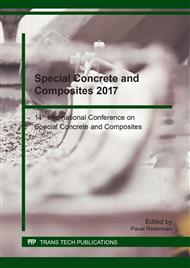[1]
F. Sanchez, K. Sobolev, Nanotechnology in concrete a review, Construction and Building Materials 24 (11) (2010) 2060 - (2071).
DOI: 10.1016/j.conbuildmat.2010.03.014
Google Scholar
[2]
S. Kawashima, P. Hou, D. J. Corr, S. P. Shah, Modification of cement based materials with nanoparticles, Cement and Concrete Composites 36 (2013) 8 - 15, special issue: Nanotechnology in Construction.
DOI: 10.1016/j.cemconcomp.2012.06.012
Google Scholar
[3]
P. Hou, S. Kawashima, K. Wang, D. J. Corr, J. Qian, S. P. Shah, Effects of colloidal nanosilica on rheological and mechanical properties of fly-ash cement mortar, Cement and Concrete Composites 35 (1) (2013) 12- 22.
DOI: 10.1016/j.cemconcomp.2012.08.027
Google Scholar
[4]
R. Polder, 8 - electrochemical techniques for corrosion protection and maintenance, in: H. Bhni (Ed. ), Corrosion in Reinforced Concrete Structures, Woodhead Publishing Series in Civil and Structural Engineering, Woodhead Publishing, 2005, pp.215-241.
DOI: 10.1533/9781845690434.215
Google Scholar
[5]
S. Sawada, C. Page, M. Page, Electrochemical injection of organic corrosionion inhibitors into concrete, Corrosion Science 47 (8) (2005) 2063 - (2078).
DOI: 10.1016/j.corsci.2004.10.001
Google Scholar
[6]
H. E. Cardenas, L. J. Struble, Electrokinetic nanoparticle treatment of hardened cement paste for reduction of permeability, Journal of Materials in Civil Engineering 18 (4).
DOI: 10.1061/(asce)0899-1561(2006)18:4(554)
Google Scholar
[7]
M. Sanchez, M. Alonso, R. Gonzalez, Preliminary attempt of hardened mortar sealing by colloidal nanosilica migration, Construction and Building Materials 66 (2014) 306 - 312.
DOI: 10.1016/j.conbuildmat.2014.05.040
Google Scholar
[8]
J. Němeček, Y. Xi, Electrochemical Injection of Nanoparticles into Existing Reinforced Concrete Structures, Springer International Publishing, Cham, 2015, pp.213-218.
DOI: 10.1007/978-3-319-17088-6_27
Google Scholar
[9]
H. Wu, F. T. Isfahani, W. Jin, C. Xu, E. Redaelli, L. Bertolini, Modification of properties of reinforced concrete through nanoalumina electrokinetic treatment, Construction and Building Materials 126 (2016) 857 . 867.
DOI: 10.1016/j.conbuildmat.2016.09.098
Google Scholar
[10]
Y. Liu, X. Shi, Electrochemical chloride extraction and electrochemical injection of corrosion inhibitor in concrete: state of the knowledge, Corrosion Reviews 27 (1) (2009) 53.
DOI: 10.1515/corrrev.2009.27.1-2.53
Google Scholar
[11]
L. Singh, S. Karade, S. Bhattacharyya, M. Yousuf, S. Ahalawat, Beneficial role of nanosilica in cement based materials a review, Construction and Building Materials 47 (2013) 1069 - 1077.
DOI: 10.1016/j.conbuildmat.2013.05.052
Google Scholar
[12]
A. Nazari, S. Riahi, Microstructural, thermal, physical and mechanical behavior of the self compacting concrete containing SiO2 nanoparticles, Materials Science and Engineering: A 527 (2930) (2010) 7663 - 7672.
DOI: 10.1016/j.msea.2010.08.095
Google Scholar
[13]
Z. Xu, Z. Zhou, P. Du, X. Cheng, Effects of nanosilica on hydration properties of tricalcium silicate, Construction and Building Materials 125 (2016) 1169 - 1177.
DOI: 10.1016/j.conbuildmat.2016.09.003
Google Scholar
[14]
K. Behfarnia, N. Salemi, The effects of nano-silica and nano-alumina on frost resistance of normal concrete, Construction and Building Materials 48 (2013) 580 - 584.
DOI: 10.1016/j.conbuildmat.2013.07.088
Google Scholar
[15]
P. Hou, S. Kawashima, K. Wang, D. J. Corr, J. Qian, S. P. Shah, Effects of colloidal nanosilica on rheological and mechanical properties of fly-ash cement mortar, Cement and Concrete Composites 35 (1) (2013) 12 - 22.
DOI: 10.1016/j.cemconcomp.2012.08.027
Google Scholar
[16]
J. Chen, S. Kou, C. Poon, Hydration and properties of nano-TiO2 blended cement composites, Cement and Concrete Composites 34 (5) (2012) 642 - 649.
DOI: 10.1016/j.cemconcomp.2012.02.009
Google Scholar
[17]
J. Němeček, Y. Xi, Nanoparticle injection into concrete using electromigration, in: Special Concrete and Composites 2014, Vol. 1054 of Advanced Materials Research, Trans Tech Publications, 2014, pp.6-10.
DOI: 10.4028/www.scientific.net/amr.1054.6
Google Scholar
[18]
J. Němeček, Y. Xi, Simulation of chloride extraction tests on concrete specimens (paper 151), in: J. Kruis, Y. Tsompanakis, B. Topping (Eds. ), Proceedings of the Fifteenth International Conference on Civil, Structural and Environmental Engineering Computing, Civil-Comp Press, Stirlingshire, Scotland, 2015, pp.1-12.
DOI: 10.4203/ccp.108.151
Google Scholar
[19]
M. S. Konsta-Gdoutos, Z. S. Metaxa, S. P. Shah, Highly dispersed carbon nanotube reinforced cement based materials, Cement and Concrete Research 40 (7) (2010) 1052 - 1059.
DOI: 10.1016/j.cemconres.2010.02.015
Google Scholar
[20]
G. Clemena, D. Jackson, Trial application of electrochemical chloride extraction on concrete bridge components in virginia, Tech. rep., Final report FHWA/VTRC 00R18, Virginia Transportation Research Council, Charlottesville (2000).
Google Scholar
[21]
E. Samson, J. Marchand, Numerical solution of the extended Nernst-Planck model, Journal of Colloid and Interface Science 215 (1) (1999) 1 - 8.
DOI: 10.1006/jcis.1999.6145
Google Scholar
[22]
R. Černý, P. Rovnaníková, Transport Processes in Concrete, Spon Press, London, New York, 2002, ISBN 0-415-24264-9.
Google Scholar
[23]
J. Němeček, P. Hlaváček, M. Kouřil, T. Jamborová, Electrochemical Injection of Nanoparticles into Concrete, Proceedings of the International RILEM Conference on Materials, Systems and Structures in Civil Engineering, Conference segment on Electrochemistry in Civil Engineering, Ed. L. M. Ottosen, Rilem Publications, 2016, pp.81-87.
Google Scholar


